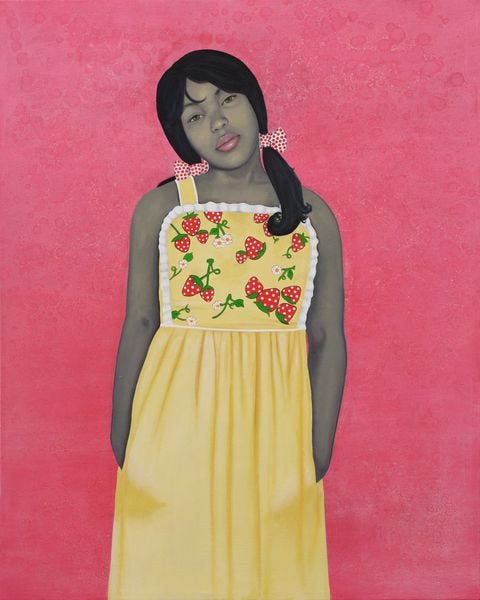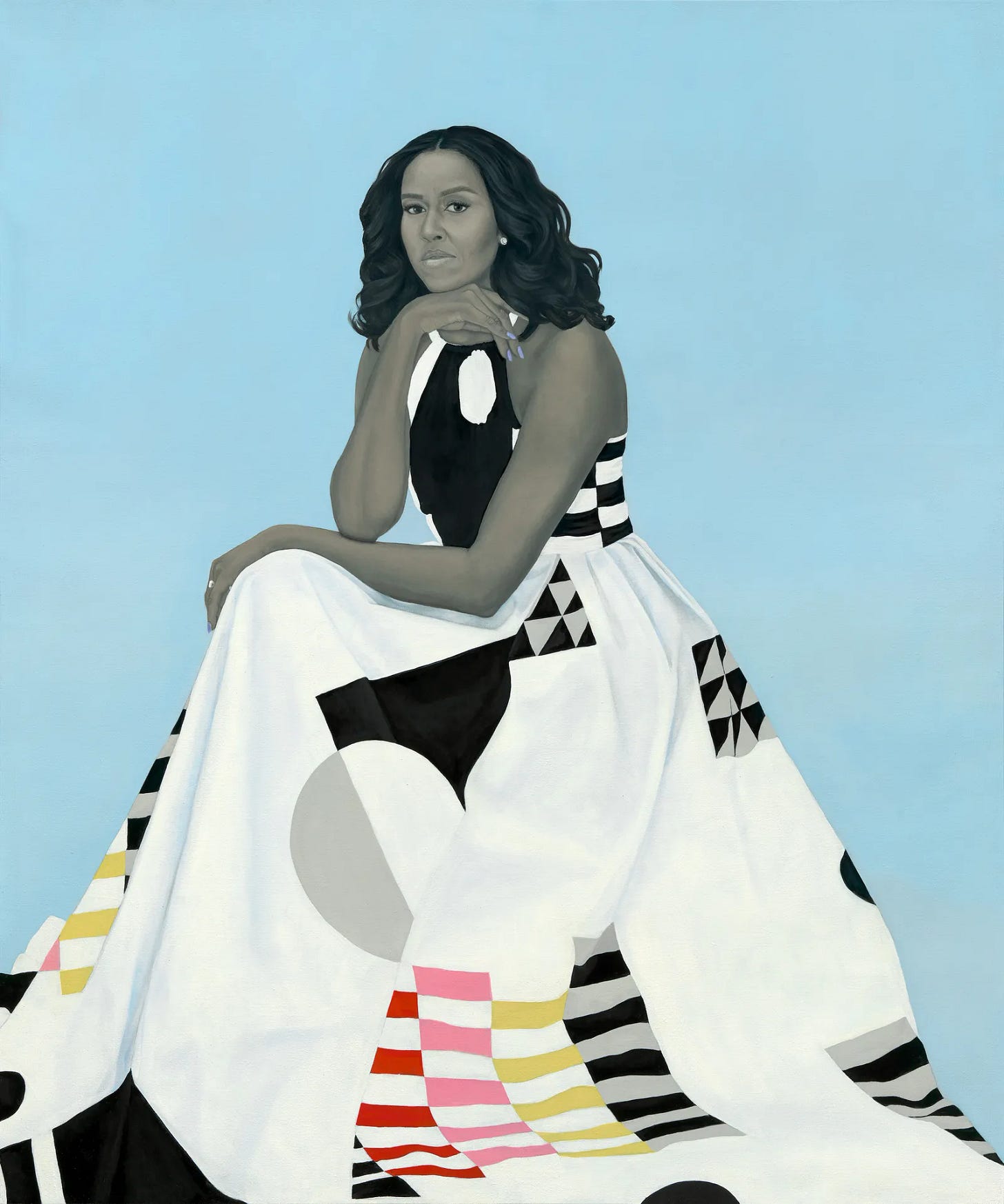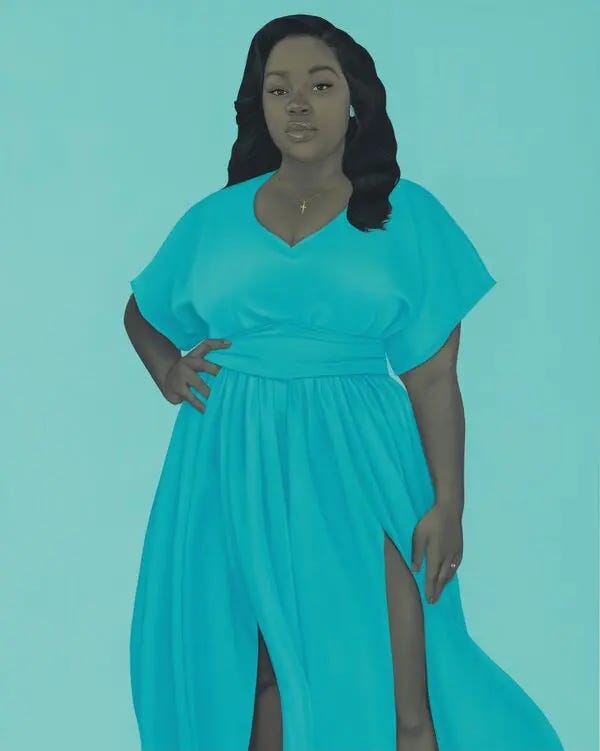
I recently visited The Whitney Museum here in New York, and I highly recommend it during their Free Friday nights.1 There’s a DJ playing on the lobby floor, and when the weather’s nice, you can take in the city views from the rooftop. The atmosphere was buzzy when I visited – spring days in New York are jubilant in that way. My husband and I book-ended our visit with a windy walk on the High Line, followed by a trip to Shake Shack and I cannot recommend this combination enough.
One of the big exhibits at The Whitney is Amy Sherald’s “American Sublime,” now on view through August 10. Hailing from Covington, Georgia, Sherald is a painter who rose to fame for her portrait of Michelle Obama, and primarily is known for Black portraiture and using a grey-scale technique for skin tones.

Sherald brings forth the personalities and sartorial touches of her subjects, often making literary references in the titles. As Jasmine Weber notes for Hyperallergic, Sherald weaves in references to Toni Morrison, Zora Neale Hurston, and other chroniclers of the Black American experience into her paintings, “embedding their legacies into the distinct visual world she’s created.”
In an interview with The Meteor, Sherald notes:
“My work was essentially born out of the desire to free myself from a history of oppression, but also in celebration of these eras of enlightenment. What I want the viewer to experience, and I say this in the exhibition [statement], is ‘the wonder of what it is to be a Black person.’ I’m no longer religious, but I speak about this in that language of flesh and spirit—because part of us always has to be activated [in fighting oppression].”
Walking through this exhibit was an emotional experience. Sherald has found a balance between the divine and grounded in her work. Most of the portraits are hung so that you feel like you’re making eye contact with every subject, in a way we rarely make eye contact these days. It feels intense and vulnerable, just like the word opia.2 In doing so, it’s not hard to ponder the wonder of being Black that Sherald describes. What emotions — grief, anger, joy, love, etc — animate her subjects’ lives? And perhaps, if we could hold the real-life counterparts with this same regard and empathy that Sherald invites us to do with these portraits, how might our world change?
There’s the 2018 Michelle Obama portrait, Sherald’s most famous work to date. Two details stood out to me – the painting’s official title references Obama’s full name (Michelle Lavaughn Robinson Obama), a reminder of Obama’s life outside of being a public figure. Another detail was the quilting on Obama’s Milly dress, which Sherald felt shared a kinship to the Black quiltmakers of Gee’s Bend, Alabama.

Another highlight – They Call Me Redbone, but I’d Rather be Strawberry Shortcake – a young woman in sunshine yellow, the title staking her right to an uncomplicated girlhood. This painting was the first I’ve seen of Sherald’s work (previously seen at the National Museum of Women in the Arts in D.C.), and I was so glad it was included in the exhibit. As Charles Moore for Art News writes:
“The title, like many Sherald chooses, adds complexity to the calm visual presentation. Strawberry Shortcake asserts her chosen name, amplified by a strawberry pattern on the bodice of her dress and the nearly solid strawberry pink background. She dares you to call her Redbone.”
Breonna Taylor’s portrait moved me to tears. Sherald painted it in late 2020 for a Vanity Fair cover to commemorate Taylor, who was murdered in a police killing earlier that year. The accessory choices Sherald makes to humanize Breonna – the cross necklace, the engagement ring – are reminders of the woman so abruptly taken by police brutality. Sherald’s Taylor portrait feels in dialogue with Jan van Eyck’s Arnolfini Portrait 3 and the tradition of in memoriam paintings, which have kept their subjects alive in the public memory for centuries.
As Najha Zigbi-Johnson writes for Essence:
“In many ways, Sherald’s subjects do not perform for the viewer; they hold their own gaze. They lean, recline, and stand in their fullness. The world around them does not dictate their pose, and there is rarely urgency in their expression. In this sense, Sherald’s work feels far from protest art or any sort of overt radicality. Yet to depict Black life, by its very nature, is political.”
I’ve written previously that fashion is in dialogue with its era – so too is art. I think about how museums around the world have responded to their own history and offerings, in the wake of the 2020 George Floyd protests.4 The Whitney too seems to be in its atonement era. A museum whose past indiscretions include promoting controversial works appropriating Black trauma, as well as buying BIPOC artists’ works at a discounted rate, the Whitney has since expanded its DEI practices, which include more diverse programming and exhibits.5 While it’s not enough to only acknowledge past wrongs, major museums making efforts to center more historically under-represented artists means there are (hopefully) meaningful opportunities for wider success.6
Zigbi-Johnson also notes the institutional context for which the work is seen is crucial:
“In a space like the Whitney Museum of Art, the consumption of her portraits by largely white audiences feels fraught. Within the museum, beauty can be misread and reverence does not always mean recognition. In this liminal space between looking and seeing, I wonder: What does it mean to see and be seen?”
Beyond Sherald’s work, this is an exciting time for portraiture. Jordan Casteel, Danielle Mckinney, and Bisa Butler are just a few artists who explore Black experiences through portraiture who have had exhibits in the past year. In addition, the Met Gala’s Black Dandyism theme, the success of Ryan Coogler’s Sinners movie, and the beginning of Beyonce’s Cowboy Carter tour are recent mainstream celebrations for Black storytelling, artistry, and community.

However, we’re unfortunately at a crisis level for the arts in the U.S. The current president’s administration wants to defund public arts, wring control of institutions, and purge cultural artifacts. He wants to put excessive tariffs on movies filmed outside of this country. Swabreen Bakr writes this could be an ‘extinction level event’ for the American film industry based on its current modes of production. These efforts by the far-right are essentially trying to erase the history, as well as the hard-earned representation of historically under-represented groups. There is no humanity in these actions.
Why are portraits an important art form even now? Alison Smith, the chief curator for the National Portrait Gallery in London, mused on this for the BBC: “It's that fellowship of human beings. Whereas in the past it was really a mark of rank or status or celebrity, I think now portraiture is more about existentialism. It's about psychology, who they are and how they fit into society. It's about identity.” I felt this way about my own Filipina identity within the diaspora, when I visited a Tokyo art museum and saw a portrait of dancing Southeast Asian women who looked like they could be my cousins.
The Whitney is not a perfect museum, but its mainstream support of Black artistry feels like a miracle in this political climate. As Sherald herself notes for The Meteor:
“When I think about Black American art history and just our legacy within the larger canon, I feel like we don’t or can’t function on the same timeline as everybody else. It still feels like the beginning of something, this moment of myself, Rashid Johnson, Lorna Simpson, and Jack Whitten [all currently having museum shows]. It feels really great despite everything that’s happening. The art world is representing the world that we want to be—the real world right now.”
Extended Reading:
The Wonder of Amy Sherald | The Meteor
A review of American Sublime | Art News
Amy Sherald’s parables of Black American life | Hyperallergic
Appreciated this post from Swabreen Bakr about the effect of Hollywood tariffs; also this one about the reaction to a new Times Square statue, and connecting Black audiences to Black art | Anti-Brain Rot
The fight to prevent the loss of Black history in federal agencies | Capital B News
The technicolor world of Bisa Butler | Print Mag (on a related note, I just ordered Bisa Butler’s book and excited to look through soon)
Jordan Casteel honors her grandmother at the Met Gala | NY Times (gift link)
The meteoric rise of Danielle Mckinney | CNN
Other Loose Buttons posts you may enjoy:
What do we wear to the revolution?
The Bloomsbury Group’s influence on fashion and style
O-Rococo flow: Inspiration from Fragonard’s works
Get a reservation, it’s popular!
From the Dictionary of Obscure Sorrows, opia is the ambiguous intensity and vulnerability of looking into someone’s eyes.
It’s an art history theory that the Arnolfini portrait is a posthumous one for the woman in the portrait, due to the multiple death symbols (snuffed candle among them) surrounding her figure.
One example: I have visited Tate Britain a couple times since 2022, and noted their recent efforts acknowledging past funding from slavery, trying to identify Black people in older paintings, and supporting Black artistry in exhibits.
Besides Sherald, the Whitney currently features exhibits and works from contemporary artists such as Christine Sun Kim, Dyani White Hawk, and Louise Nevelson, among others.
I should note as a biracial Asian-American woman, I can only offer my limited perspective, and cannot speak broadly to the experience of how this feels for others, or whether these museum efforts meet the moment or ring hollow.








Also love love love Danielle McKinney's portraits. They speak to me in a really deep way, the energy in them is so palpable. My dream is to afford one of them lol.
Thank you for citing me in this piece!
Your review of Sherald's show made me want to see it. I have complicated feelings about her work. Revisiting her portrait of Breonna Taylor now in the midst of the controversy around Thomas J. Prices's sculpture of a full figured fictional Black woman that is seen as inadequate by a lot of Black people, makes me wonder how that portrait of Taylor would have been received if she was drawn in a more naturalistic state. The portrait is very glam and fits contemporary expectations of beauty and was meant to celebrate her life.
Edited to add: I just looked at the exhibition images! Interesting that part of the positive reception for her works is the fact that the people in them are very stylish and fall more safely into looking 'respectable.' much to unpack here!